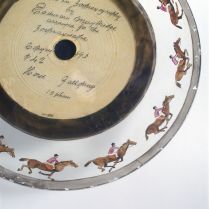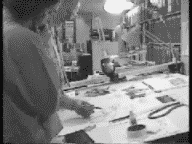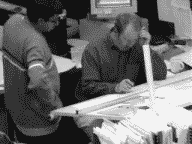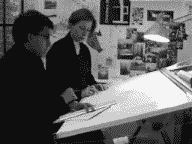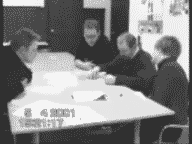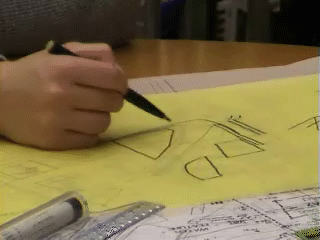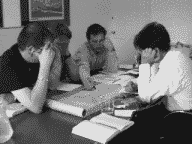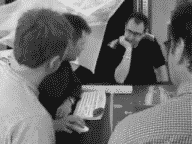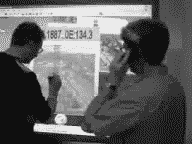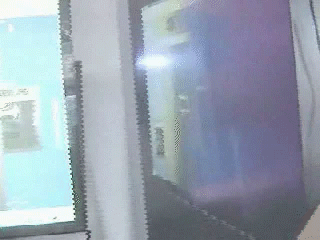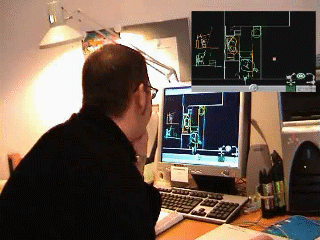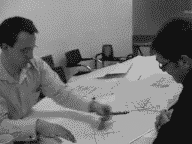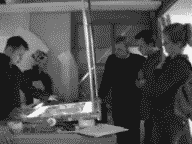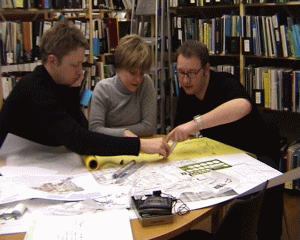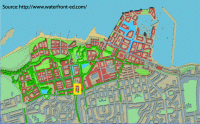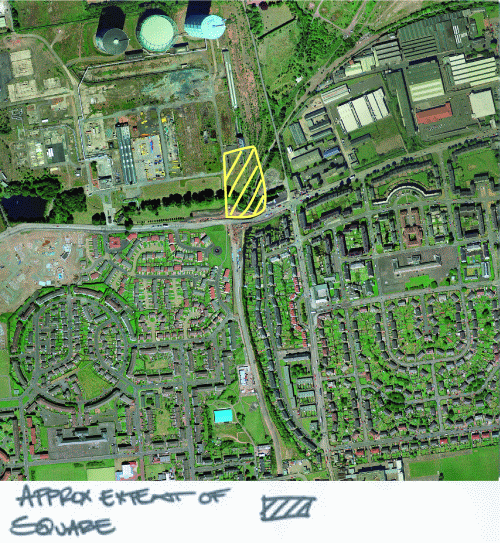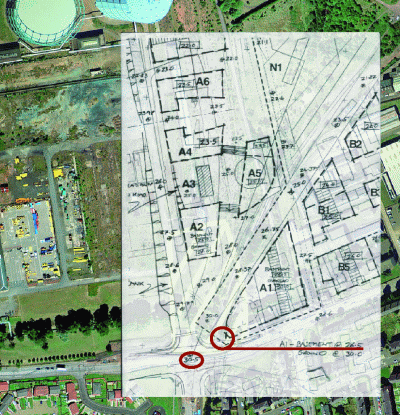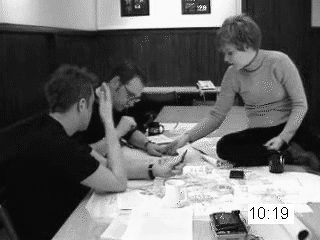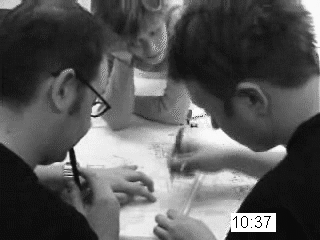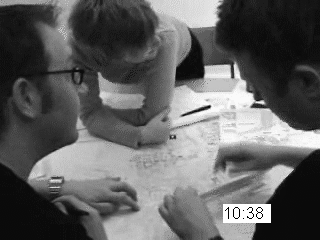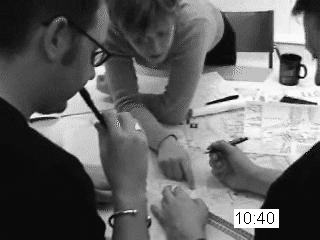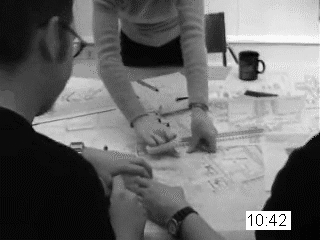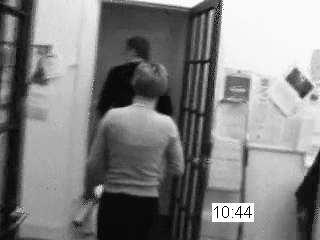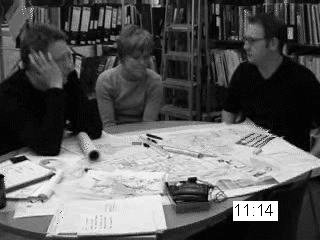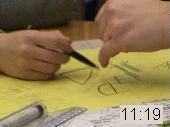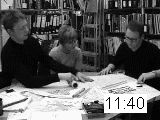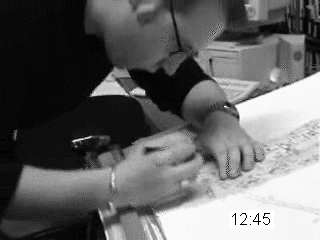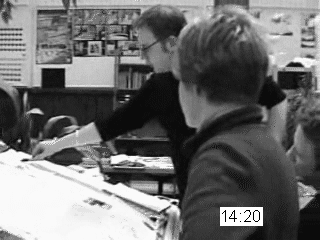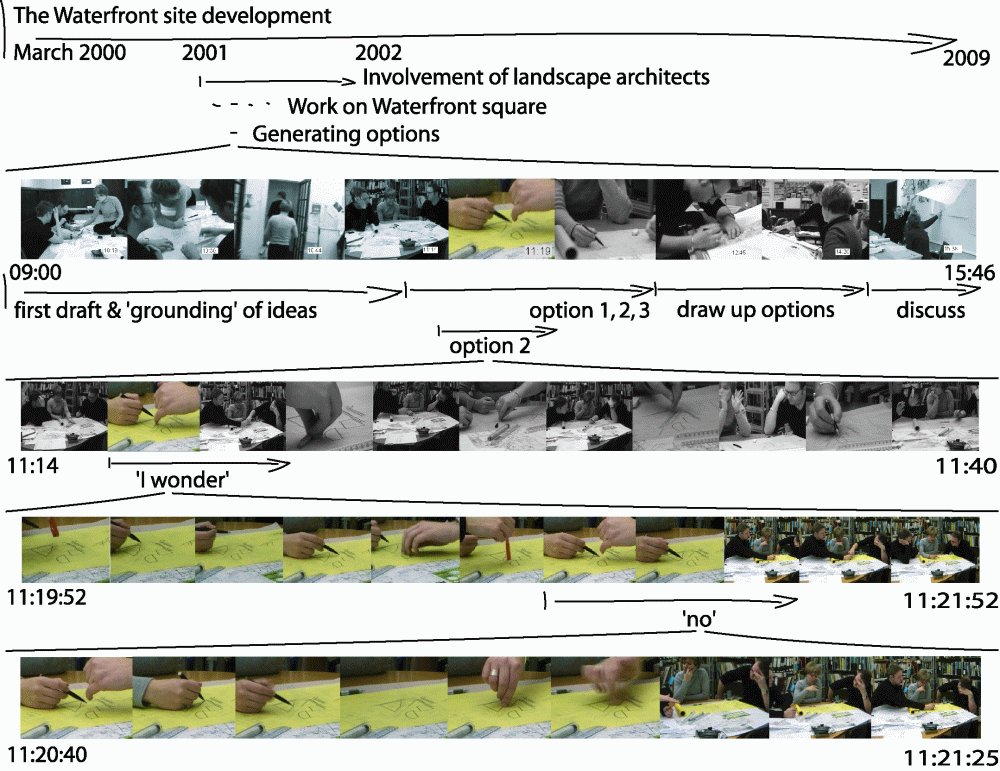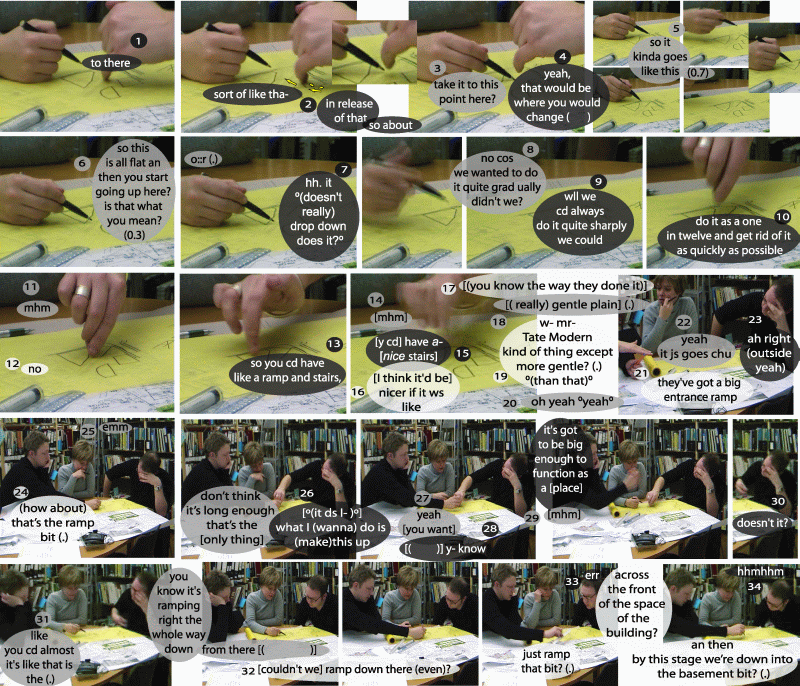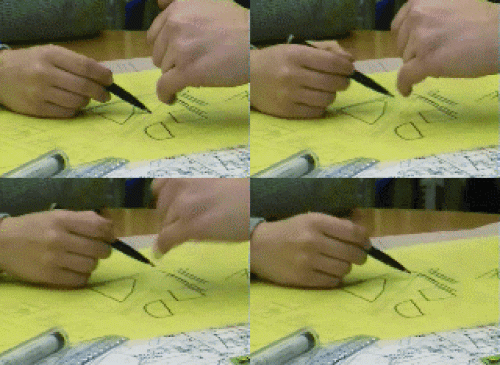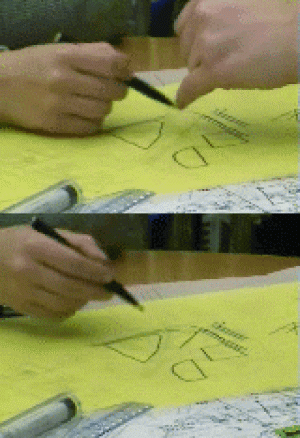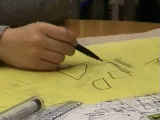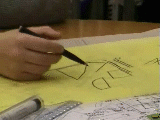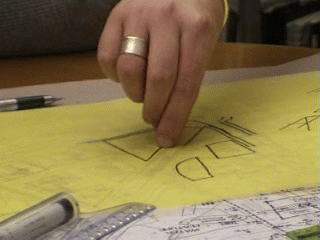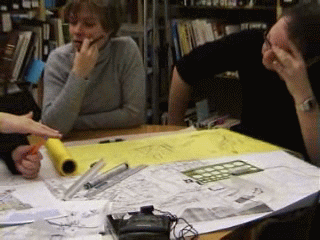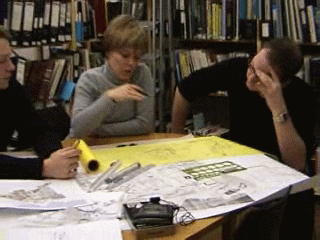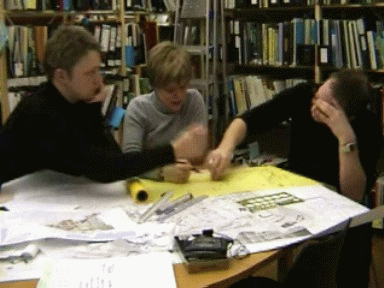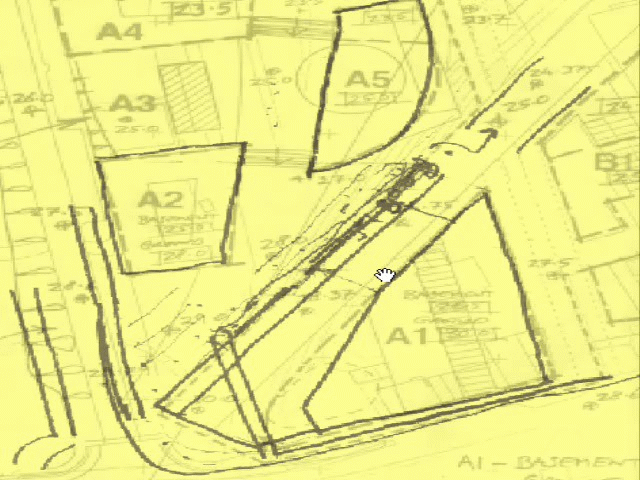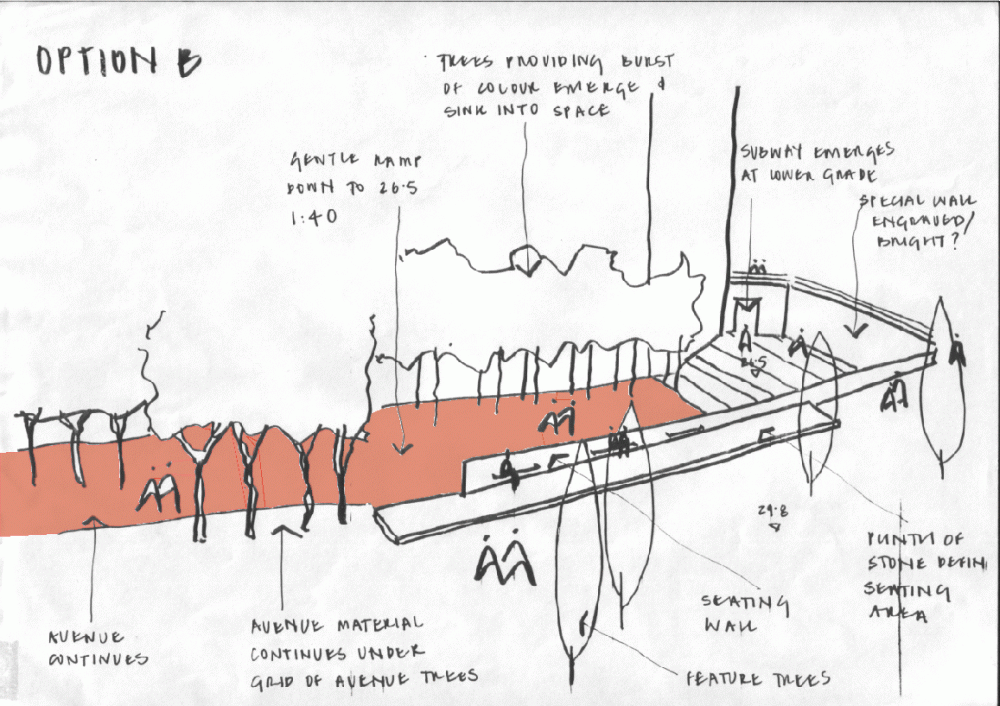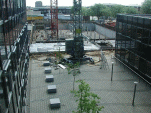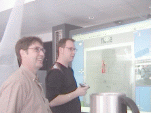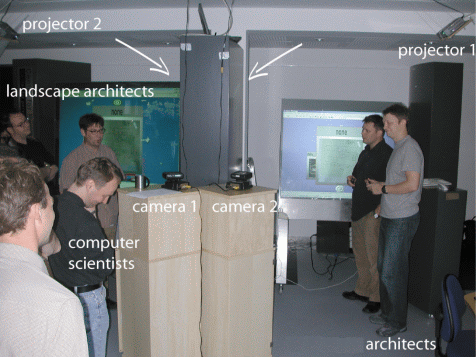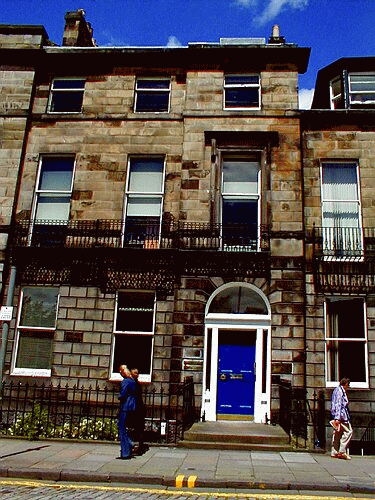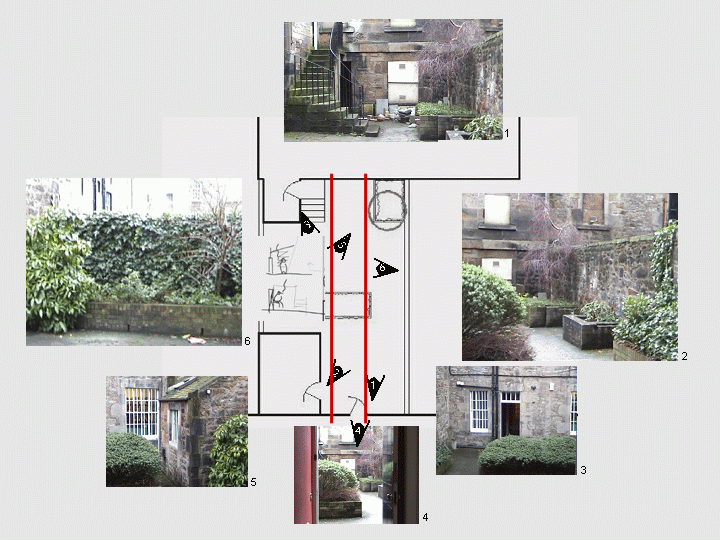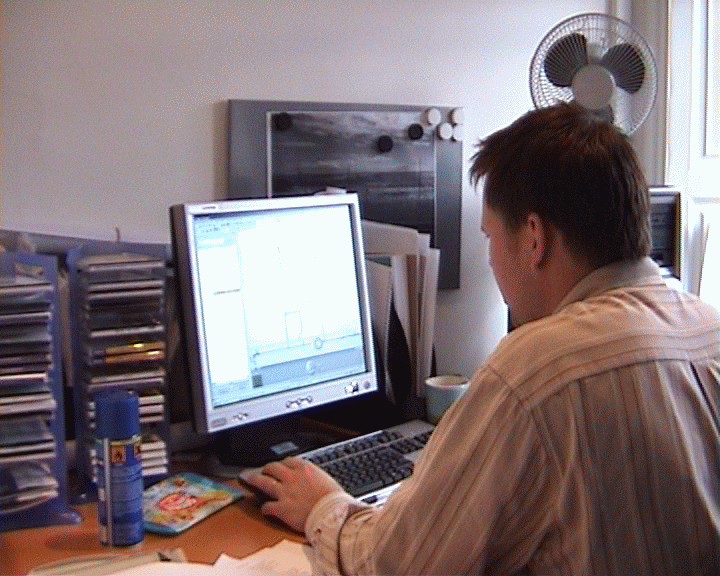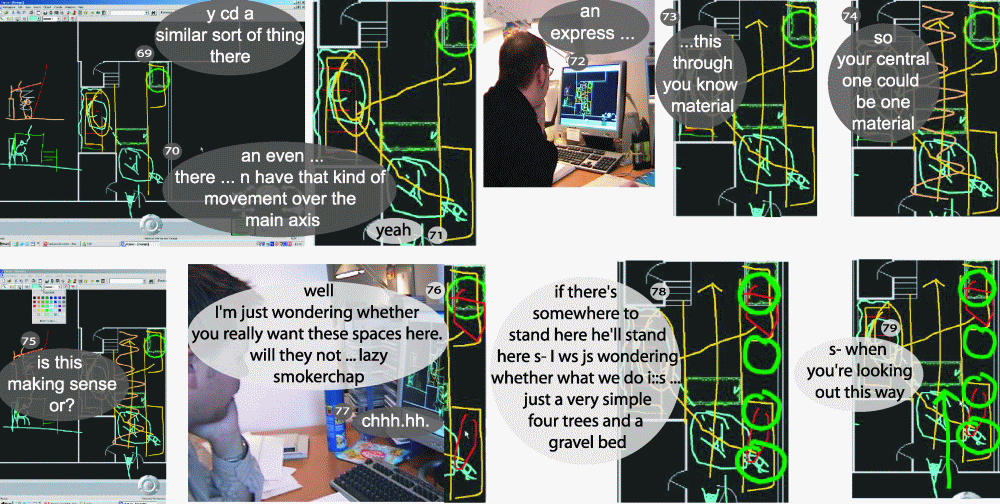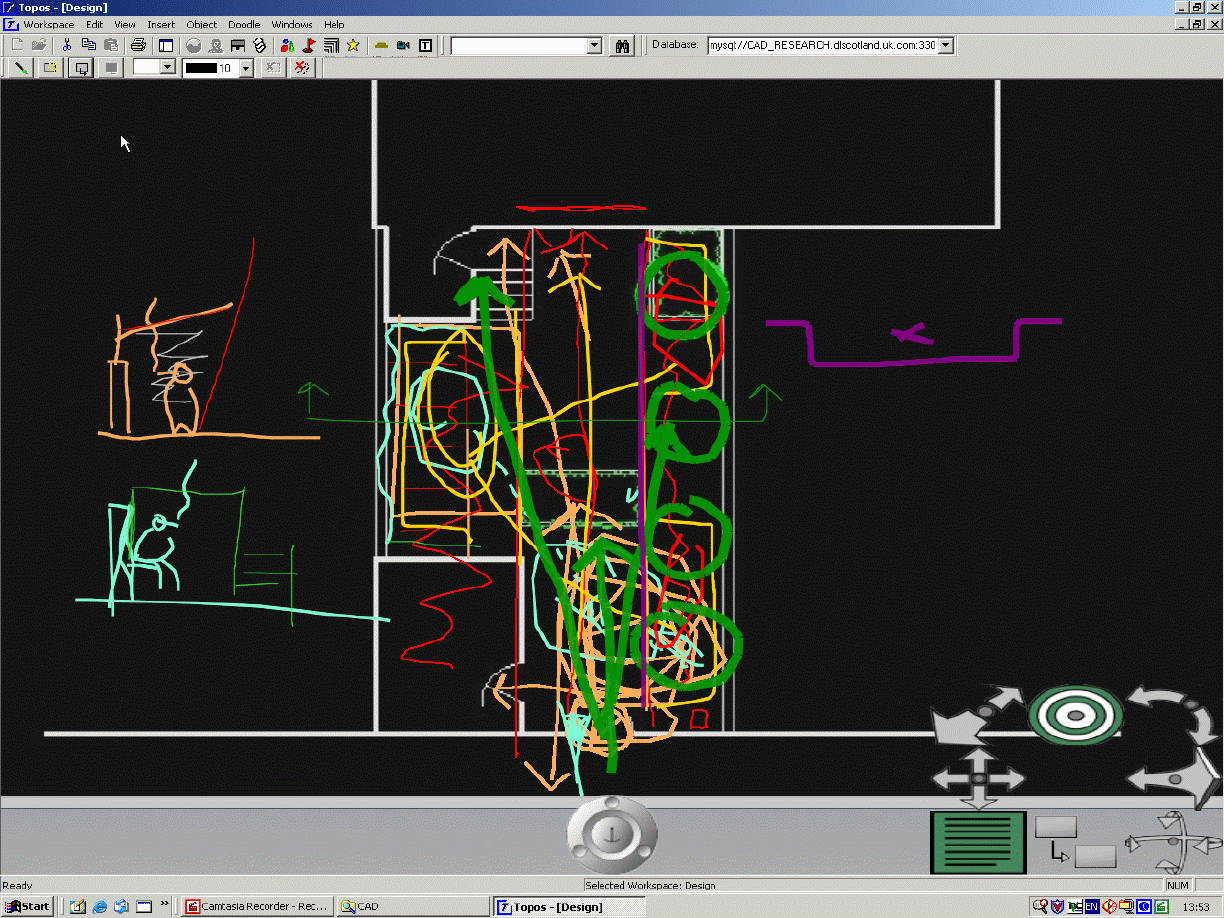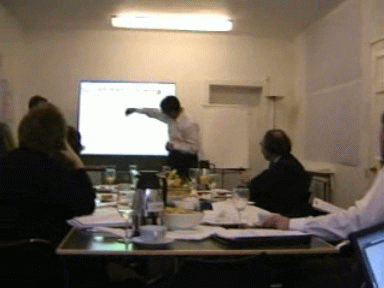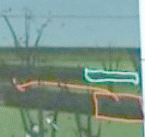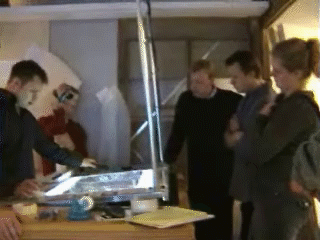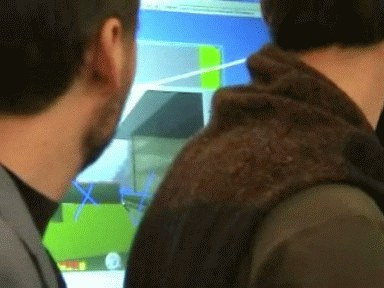Social Life Under the Microscope?
by Monika Büscher
Lancaster University
Sociological Research Online, Volume 10, Issue 1,
<http://www.socresonline.org.uk/10/1/buscher.html>.
Received: 28 Jul 2004 Accepted: 10 Mar 2005 Published: 31 Mar 2005
Abstract
Video is an important new instrument for sociological research, sometimes welcomed as the 'microscope' of social science. It provides access to important and otherwise difficult to examine aspects of human interaction. Moreover, because video captures practice in its lived production as 'another next first time' (Garfinkel 2002), it makes it possible to study practical creativity - the way in which people invent new practices. In this paper, I probe the microscope metaphor through concrete examples from my work with landscape architects and computer scientists in participatory technology research and design projects.
Keywords: Video Analysis, Time, Socio-Technical Change, Practical Creativity, Imagination,
Introduction
1.1 Video recordings are increasingly acknowledged as important tools for sociological inquiry (Banks 2001). Inspired by qualities that already captivated the inventors of the motion picture (Figs. 1 & 2) [1], the video camera is sometimes welcomed as the 'microscope' of social science (Goguen 1997).
|
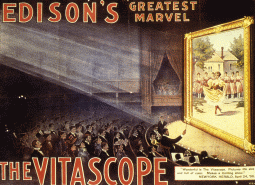 |
|
Figure 1 E. Muybridge, Zoopraxiscope (1879). |
Figure 2 T. Edison, Vitascope (1896). |
|
1.2 The analogy provokes both useful and misleading associations. In this paper a close look at video and its affordances for sociological research is interwoven with two substantive strands of inquiry:
- Design sessions. Over the past seven years I have been a participant observer in different landscape architecture practices. Landscape architecture is a site of many interesting social phenomena, but design sessions and their in-situ production as social scenes are one of the most fascinating.
- Socio-technical change. Part of the motivation for my ethnographic study is the landscape architects' and my own engagement in technology design[2]. People's practices change in interaction with new technologies, and to create new technologies that 'fit', designers need to anticipate and design for future practice. As part of our approach, we therefore 'force' the future in a way that fosters technical as well as practical creativity, or the development of new ways of working. Long-term participant involvement in the making of present, and the forcing of future material working cultures in landscape architecture makes an ethnography of socio-technical change possible, where new practices can be seen to emerge.
1.3 My use of video as part of these investigations provides concrete examples to probe the microscope metaphor. After a brief discussion of some core connections between the substantive and the methodological concerns in this paper, I present an analysis of current design work practice in landscape architecture in part 3-6, turning to socio-technical change, technical and practical creativity in parts 7-10. Throughout, the analysis also serves as a methodological exhibit and, periodically, I ask whether the examples represent 'social life under the microscope' - not because I believe they do, but to explore how, what, and with what effects social scientists might see with a video camera.
Background
2.1 Professional vision is deeply intertwined with its instruments (Goodwin 1994, 1995). This is true in many different domains, as Goodwin and other analysts show (see, for example, Hutchins 1995, Latour 1999, Hindmarsh and Pilnick 2002). In the natural sciences, microscopes have been shown to be instruments to see with rather than through (Hacking 1983, Lynch 1985), and when it comes to sociological inquiry, instruments also do not provide a way of 'seeing "through" ... to an underlying reality' (Garfinkel 1967, p. 96).
The Power of Video
2.2 This recognition does not make video any the less useful for sociological analysis, and the analytic potential and constraints of this relatively new instrument of sociological inquiry are beginning to be mapped out. There are several exemplary studies that highlight the access video provides to otherwise difficult or impossible to examine aspects of human interaction (e.g. Heath and Hindmarsh 2000, Goodwin 2003). Lomax and Casey (1998), and Mondada (2003) examine the accommodation of video-based observation/participation into naturally occurring activities, while Jordan and Henderson (1995), Heath (1997), Meier (1998), Macbeth (1999), Goodwin (2000), Heath and Hindmarsh (2002) and (Mohn 2002) discuss important challenges and possibilities of video methods.
2.3 The power of video derives in no small part from the temporal manipulations it affords. Repeat viewing, 'dissection' through slow motion and frame-by-frame analysis, as well as comparison through fast forward and data banks are powerful elements of video analysis.
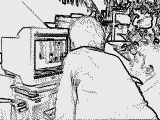
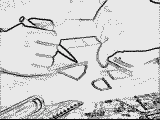
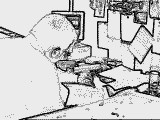
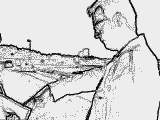
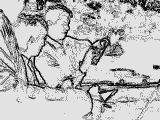
Figure 3 Landscape architects at work - in their studio and on site.
2.4 Control over time and sequence helps to reveal the scenic intelligibility of the world - the fact that we can usually tell what people are doing by looking. It is described by Lena Jayyusi (1988, 1991), who points out that the seeing and the making of social scenes are cultural, practical, and sequentially organised achievements. People have ways of making life 'scenic', of making interaction intelligible, simultaneously making scenes witnessable for outsiders. These 'ways' are 'ethnomethods' (Garfinkel 1967) and their study in landscape architecture is fascinating, not least because work in this professional domain is creative, aesthetic, but also highly precise, even 'scientific', and it involves information intensive, collaborative, mobile, indoor and outdoor work (Büscher 2004).
2.5 But video also supports different, less microscope-like temporal manipulations for analysis. Concerned with the lived 'another next first time' (Garfinkel 2002, p. 98-99) of social order in the making, many ethnomethodologists focus on the production of the mundane, familiar orderliness we take for granted when they ask 'How much the same do actions have to be to be recognizable as the same?'(Garfinkel 2002, pp. 23, 138-139). Insightful studies document the actions and ethnomethods involved in 'passing' as a woman (Garfinkel 1967), making business decisions (Boden 1994), giving answers (Button 1992) and many other activities. Sameness and variation is examined through typical examples. However, it can also be useful to take a more diachronic approach, to compare across time and focus on improvisation, practical creativity and change. Video is a powerful instrument in this endeavour, too, as we will see.
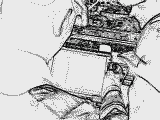
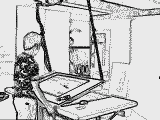
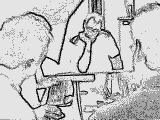
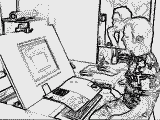
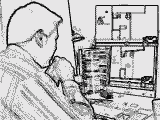
Figure 4 Landscape architects at work - with prototypes of future technologies.
Design Work
2.6 Design sessions are perhaps the most fascinating facet of scenic intelligibility in landscape architecture, not least because design is a practical art and at the same time draws on advanced abstract, aesthetic, and creative knowledge. Garfinkel's programme of ethnomethodological studies of work (Garfinkel 1986) has inspired an epistemic sociology (Lynch 1993) that engages in detailed studies of epistemic activities. However, the persuasive argument that such an approach can reveal the organisation of epistemic practices has resulted in only a handful of studies (see, for example, Garfinkel et al. 1981, Lynch 1985, Lynch and Jordan 1995, Livingston 1987, Livingston 1999, Bjelic 1996, for similar approaches see also Shapin and Schaffer 1985, and Knorr Cetina 1999). Moreover, these studies focus on observation, measurement, or experimentation. Imagination, intuition and aesthetic judgement receive little attention although even scientific innovation is unthinkable without them (Harré 1981). A compelling new line of inquiry can be opened up by expanding the focus of epistemic sociology to include less rational and objective ways of knowing. Design work is a perspicuous setting (Garfinkel 2002) where they can be studied. The question is 'how?'.
2.7 Lynch's epistemic sociology is an ethnomethodological response to a sociology of scientific knowledge that takes issue with the claim that scientists have objective access to the truth about an inherently ordered external reality (e.g. Latour 1999). A parallel case can be made for the sociology of art and design that replaces the terms 'objective', 'truth', and 'reality' with 'disinterested', 'beauty', and 'aesthetic objects' and engages in a similarly critical endeavour (see Heywood 1997 for a review). The main benefit of a sociological perspective, sociologists of art and design argue, is that it 'exposes the origins and interests involved in aesthetic judgements' (Wolff 1993, p. 29), and aesthetic 'disinterestedness' is revealed as a cultural construction that simultaneously denies and serves the economic and ideological interests of the art world (Bourdieu 1980). Not unlike scientists who construct reality as independent from their thoughts and actions and actively create a 'culture of no culture' (Traweek 1988, p. 40-1), designers, architects, artists and art critics perform disinterestedness and thereby attain the 'power to consecrate objects' (Bourdieu 1980, p. 262). The sociology of art traditionally tries to see through the performance to reveal the interests and influences that are at work in the background.
2.8 However, a focus on interests often means that the practical achievement of imagination, intuition, creativity and aesthetic judgement remains opaque, even seems irrelevant (Armour 1996). In fact, the aesthetic appears to crumble into nothing but a network of interests. Wolff herself (1993) warns against such reductionism. In the last analysis, she states, aesthetic value is irreducible to 'social, political, or ideological co-ordinates' (ibid., p. 1). Trying to find an approach that is more mindful of the 'specificity of art', Wolff turns to an archaeology of the aesthetic 'to discover whether ... proportions, volumes, and contours were not, at the period in question, ... enunciated, and conceptualised in a discursive practice' (Foucault 1972, quoted in Wolff 1993, p. 93). Wolff concludes that the specificity of the aesthetic 'is identical with the discourses of the aesthetic' (1993, p. 94). Yet, even though she also identifies Wittgenstein's approach to 'discuss the aesthetic by referring to the criteria for the application of aesthetic terms' (1993, p. 81) as a source of inspiration for a sociological approach, Wolff does not expand her critique in this direction. Instead, she turns to psychoanalytical theories. As a result, imagination, intuition, creativity, and aesthetic judgement are shown to be socially determined, but mainly cognitive phenomena.
2.9 The detailed study of examples of lived aesthetic practice in this paper shows that such a rendering can be misleading. It allows some ethnomethodological exploration of questions about the 'specificity of design' . However, the chief focus remains on the microscope metaphor.
Design Sessions
3.1 Design sessions are the 'engine room' of imagination in landscape architecture. They are frequent, clearly recognisable events and often mark crucial stages in the design process. They are a site of production: of ideas, of imagination and aesthetic judgement, and of a design session as a recognisable social scene. Figure 5 shows snapshots of some of the activities involved.
Figure 5 Twelve design sessions - filmed between August 1997 and November 2003.
Those in colour are described in more detail below. Click on the image to see a videoclip. You may need to install the free Divx codec. ![]()
3.2 An observation by Garfinkel and Sacks highlights a key element of these activities:
... along with whatever else may be happening ... it may be a feature of the conversation for the conversationalists that they are doing something else; namely, ... saying-in-so-many-words-what-we-are-doing (or what we are talking about ....). We shall speak of [these] conversationalists' practices ... as formulating. (Garfinkel and Sacks 1970, p. 351)
3.3 In design sessions, landscape architects are concerned with saying-what-we-are-seeing and what-we-are-imagining. The object of design is akin to the object of discovery described in Garfinkel et al. (1981) in that it is a 'potter's object'- seen, evaluated and simultaneously shaped or 'formulated'- through the very words and references that describe it (see also Lynch 1993, p. 192-194). Design sessions also draw to our attention that formulating is not restricted to talk, as drawing, gesturing, enactments, and embodied reference to images, plans or features in the surroundings can all reflexively formulate the imagined object and the scenic intelligibility of the activity.
3.4 Every 'ecological huddle' (Goffman 1983, p.3) in the studio where talk, gesture, and drawing occurs, where plans, maps, and photographs are used, and sketches are produced, is likely to be a design session. They can take minutes or hours, be planned activities or develop spontaneously, involve few or many, landscape architects but also professional partners - planners, engineers, architects, contractors. This delineation of some key characteristics should equip readers to recognise design sessions.
Social Life under the Microscope? Into the Scene
4.1 However, we are on the outside, looking in on the scene like a scientist studying a drop of pond life under a microscope, when really we need to be on the inside, participating. It is in the actual making of social scenes that ethnomethods become visible, and this dynamic and ephemeral object of interest requires a special mode of inquiry. 'Anticipatory following' is an analytic method that involves understanding activities whilst actively participating in their production (Garfinkel 1967, p. 147). The late anthropologist and filmmaker Jean Rouch expressed this ethnographic mode of analytic participation more poetically, when he described the continuous shot, where the camera anticipates and moves with the actors, as an important element of his approach to filming:
nothing is given in advance ... the smoothness of a faena (strategy of play) in bullfighting is analogous to the harmony of a shot ... in perfect balance with the movements of the subjects ... (Rouch 1975, p. 93, quoted in Macbeth 1999, p. 147)
4.2 Drawing on Rouch, Douglas Macbeth shows how the continuous shot can reflect the anticipatory-responsive, analytical-participant character of participant observation as an 'inquiry from within the social order' (Macbeth, 1999 p. 163). My own continuous shots are less elegant than the examples Rouch and Macbeth describe, but important as courses of in situ inquiry. Unlike a scientist who extracts a 'slice' of life to study it under the microscope, I actively participate in the unfolding scene and produce a record from within. These recordings and experiences form the backbone of my analysis and furnish the material for the descriptions of design-sessions-in-the-making below.
4.3 These descriptions invite participation. I provide video clips, transcriptions, explanations and analysis (abridged versions in the printable text, with further material provided online ). Active engagement with these ethnographic accounts involves a participant observer's frame of mind on the reader's part. The reward, I hope, is a sense of involvement from within the activities-in-the-making. Moreover, since participation is facilitated with the help of video records and video analysis, the reader will also gain some experience of using this instrument for sociological research.
Designing an Edinburgh Plaza
4.4 Andy Patterson, Debbie McKeen, and Ross Wilkie (Fig. 6)[3] get together to come up with ideas for an urban plaza that will mark the entrance to a new mixed development - housing, offices, cultural venues and open spaces - as part of the regeneration of the waterfront in Edinburgh.
Figure 6 Andy (on the left), Debbie and Ross, the masterplan for the new development, and the location of the square (yellow box).
4.5 The main design issue is the need for level changes which means that the plaza cannot be flat. At the south end, people have access at 30 meters from the road and at 26.5 meters from a subway exit (indicated by circles in Fig. 7 below). In aesthetic terms this is a challenge - how to allow access from different levels without dividing the space?
Figure 7 The square on the aerial photograph and on the plan. ![]()
4.6 A first exploration generates several ideas and one of these will be discussed in this paper. It emerges first around 10:19, when Debbie, Andy and Ross consider using different materials to indicate routes and access at different levels (Fig. 8). As they are working out points where materials should change, tracing them through transparent tracing paper overlaid on the plan, a colleague tells them that he needs the room (10:38). Andy, Debbie, and Ross rush through identifying remaining routes (10:40).
Figure 8 Identifying routes and points of access. ![]()
4.7 They stick the tracing paper in place on the plan (Fig. 9, 10:42), and move to the library (10:44), where they spread out again, and spend one hour and a quarter discussing and sketching some of the ideas they discussed earlier. The option that involves the use of different materials is picked up at 11:14, and sketched to everyone's satisfaction by 11:40. It fills 2/3rds of the sketch. The three designers separate to draw this and one other idea up in detail (12:45), comparing styles and sharing the work (14:20), and eventually discuss their ideas with a senior colleague (15:38).
Figure 9 Moving base, sketching, drawing up, and discussing options. ![]()
4.8 I followed Andy, Debbie, and Ross over the course of the day. This design session (like any social scene) is recognisably produced here and now for another next first time. It is familiar and at the same time unknown, only discoverable and 'do-able', and this simultaneously routine and emergent character can be studied in some detail and to great effect. I have selected a particular sequence of moves for closer scrutiny. However, as we turn to it, I will explain the processes of its capture and selection, focussing on the temporal manipulations that were part of it.
Social Life under the Microscope? Seeing with Time
5.1 Real time. Ethnographic fieldnotes and interviews are useful, but the real-time production of social life happens faster than any note-taker could document, often quicker and with greater complexity than a human observer can consciously perceive, let alone memorize. Moreover, post-hoc reflection tends to replace the prospective logic of production with retrospective rationality. For me, ethnographic participant observation documented with a video camera is, therefore, the most useful tool for the study of social life in-the-making. However, a mechanical recorder and participant observation do not sit together easily. Participation involves moving with the landscape architects, holding doors, helping to carry equipment. In most situations it requires a handheld camera. Moreover, if a choice is necessary, I prioritize participation over the quality and comprehensive-ness of video records. I do not strive for objective independence from the activities I study nor do I continuously monitor my own interpretative process (Pink 2001) by placing subjectivity at the heart of the inquiry. Instead, the intersubjectivity of human action is a resource in the search for an understanding of the practical production of activities from within.
5.2 The long term. Participant observation like this demands that the practitioner participants in the ethnography understand and ideally share the motivation for the study. Collaborative analysis, in designated sessions (Karasti 2001), but especially as part of a more thoroughgoing endeavour can be a catalyst for this. The landscape architects and I work together with computer scientists as members of a team in projects that last (at least) three years. We undertake hybrid studies of work (Garfinkel 1986, 2002) in the sense that the landscape architects, software and hardware designers, and work analysts work with/for each other. Sociologists and landscape architects become technology designers, technology designers and landscape architects are sociologists, and the technology designers and sociologists must become at least passively competent landscape architects. We learn and cross boundaries as we share an interest in, and a responsibility for, work analysis, but also through the practical work of translating analysis into tangible technologies. Workshops, technology design sessions, and experiments help us to iteratively evaluate and develop analytical insights.
5.3 Simultaneity. As a result, if I need to see what people are doing, I can look closely without disturbing the naturally ongoing production of activities too much.[4] My camera comes with me (example). It captures events and simultaneously records my own in-situ analysis of, and participation in, unfolding events (Meier 1998, Macbeth 1999). The camera is a recorder of what I see and how I see, in effect part of my ethnographer-camera 'cyborg' body. The ideal result of this form of participant observation might be that viewers of the resulting footage 'no longer see a camera looking but find an unfolding scene' (Macbeth 1999, p. 159). However, such gems are rare amongst my records ( 5.4 Synchronising. My camera has a limited view of events. While I am part of the scene, with a mobile field of view of 180º (including peripheral vision) and a highly flexible focus, my camera has a much narrower field of view and only gets the focus right if I continuously monitor and adjust it. As a participant observer I cannot always do this well, which sometimes makes for less than perfect records. But this approach makes it possible to simultaneously engage - intuitively and analytically - and record, allowing me to tap into the intersubjectivity of interactions as an analytic resource and practice anticipatory following. However, simultaneity requires work. What exactly anticipatory following with a video camera involves, and what the benefits are in comparison to more traditional ethnographic methods is best explained by delving deeper into the example.
5.5 On this occasion, I took one continuous shot from 10:19 to 12:01 - only interrupted by a change of tape after 90 minutes. A number of shorter shots were taken after lunch, and another continuous shot from 14:10 to 15:46. The series of pictures in Figure 10 isolates smaller units of analysis, identified through recognition of scenic characteristics. The beginnings and ends of discussions of design ideas, for example, are usually marked by either Andy, Debbie, or Ross saying 'right, okay', and rolling out blank tracing paper over the plan. Analytical identification of scenes occurs post-hoc, but also in situ, where it is documented in the video record as an attempt to synchronise the different fields of view of engagement, analysis and recording.
5.6 Lag. Synchronisation is very rarely a complete success, not just due to limitations of the camera. When it comes to studying the production of everyday practice, particularly within one's own culture, sociological perception is handicapped. My own everyday engagement in everyday practice blunts my analytic abilities. It is hard to make the familiar strange. Design sessions seem, at first glance, ordinary, a form of conversation. Familiarity breeds time lags between my embodied, intuitive and analytically unnoticed noticing of interactionally relevant events, my embodied participant analysis and that augmented by my camera.
Figure 11 Identifying routes and points of access. 5.7 For example, at 10:19 in Figure 11, the camera is recording a medium shot. The landscape architects are turning their attention to routes and points of access, discussing them in broad brushstrokes. Several minutes later, Ross places a fresh sheet of tracing paper on the plan and Andy moves in immediately, identifying building footprints. Their focus has shifted to pinning down entrances, exits, and paths precisely. I do realise that this is likely to give rise to more fine grained organisationally relevant events on the sketch, but by the time I shift my own focus (and that of my camera), the discussion is already in full swing. On the one hand such 'missed beginnings'[5] represent missed data, but on the other, they teach me to anticipate moves more perceptively. Both missed and captured events make this inquiry from within an important analytical resource: there and then and when re-viewing the recording.
5.8 SlowFastSLow. Alone with the video tape I fast forward through hours of records, proofing my decisions about levels of analysis or units of activity by comparing beginnings, ends, and activities with similar kind of episodes on other days (Fig. 5 ). Logs and tags aid retrieval in a database of over 400 hours of records, but search is a frequent and time-consuming part of analysis. However, it is not just a nuisance but also a means of discovery and of training perception. Speeding through and slowing down short sequences of interaction, the familiar becomes strange. Moreover, the slowfastslow of fast forward, playback, rewind, replay, rewind, replay, 'dissection', fast forward ... puts me back in the scene. I see again, through my ethnographic camera-eye what I experienced first hand some time ago. The record captures my own ongoing, intuitive participant's analysis in-situ, my social scientist's noticings and my (sometimes more, sometimes less successful) attempts to record key events. It includes - initially often off-screen - the clues that allowed me to grasp, notice and (hopefully) record the production of activities.
5.9 Time travel. It is difficult to facilitate 'time travel' and to make the real-time experiential aspects of the prospective-retrospective logic of activities-in-the-making available to others without relying on their having experience of similar ethnographic inquiry. However, an invitation for readers to adopt an active participant observer's point of view (as part of their engagement with the analysis presented here, but also as part of their own everyday participation in similar activities) can help, because
5.10 Like calculation, inference or measurement, imagination and aesthetic judgement are, to some degree, familiar practices. This makes it possible to understand and participate through anticipatory following without first having to become a competent practitioner oneself. This is true for the ethnographer, but also for the reader. There are different modes of participating as a member in social scenes and epistemic activities, from the passively competent bystander, through to the novice, to the proficient expert. Of course, long-term participant observation makes it easier to appreciate the highly cultivated skills of professional practitioners, but it is, in principle, possible to understand a great deal without lengthy apprenticeship.
5.11 The use of video for social science outlined here bears little resemblance to that of a microscope in science. Rather than extract a 'slice of life' for study, seeing with time encourages participation and acknowledges, in fact, makes a virtue out of, the inescapably endogenous nature of sociological analysis (Lynch 1993, Ch. 4 & 8). However, the slowfastslow of fast forward, playback, rewind, etc. also helps to identify sequences for 'dissection'.
6.1 A purpose of many design sessions is to generate and think through design ideas. In this day's work there are two phases. Andy, Debbie, and Ross initially explore existing conditions with the help of plans and maps and generate options (09:00 - 10:45). Later, three of these are developed by sketching. The option with material changes sparks the most discussion (Fig. 12, 11:14 - 11:40). In the course of it, the three formulate the look, feel, and usability of different kinds of solutions to the level changes on the prospective plaza (11:19:52 - 11:21:52). One such formulation: 'We could always do it [drop one half of the plaza] quite sharply' sparks a disagreement (11:20:40 - 11:21:25).
6.2 A crucial element of Andy, Debbie and Ross' idea to use different materials to indicate routes and points of access at different levels is a 'sunken space', and the disagreement arises over its shape. Ross has missed a few minutes of the discussion about how to create this area. However, he tunes in seemingly without effort:
Figure 13 A disagreement.[6] 6.3 Ross suggests taking it 'to there', 'like tha-'. These indexical expressions only make sense in combination with the movement of Ross' little finger (Fig. 14). Early on, Debbie indicates that she wants to contribute with a tiny flick of her pen. Ross accommodates this by making a transition point in his talk and on the drawing. He says 'so about', making room for Debbie's pen by lifting his little finger, allowing her to complete his thought: 'take it to this point here?'. Ross' answer comes with an invitation. He tilts his little finger to point into the direction he will take next. Debbie joins him and then proceeds to draw lines that re-formulate what she and Ross have just described in word and gesture. She pauses and formulates implications: 'so this is all flat and then you start going up there? 6.4 These few seconds show very clearly that imagination is not simply a mental process, and not just a capacity of individual minds. It is also a social, intersubjectively intelligible, practical achievement. It is dynamic, embodied and 'environmental' and can be highly collaborative. Collaboration can be as subtle and procedural as Debbie's flick of her pen to indicate a wish to participate in the formulation of this area of the plaza, but it can also be a driving force for the imagination:
6.5 Interpretations, mis-interpretations, and descriptions allow Andy, Debbie, and Ross to formulate level changes on the plaza. Each word or gesture exerts pressure on, and shapes, the imagined space like a 'potter's object', and this process of formulating seems to hold the key to understanding aesthetic practice.
6.6 There are many formulations and many different formats. Within the space of a few seconds, we move from the wiggle of a little finger, through plan view lines on sketching paper overlaid on a plan, to verbal descriptions. Later, these are elaborated through further gestures, words, figurative and plan view sketches, and perspectival illustrations (Figs. 15 and 16).
But the question of exactly how formulations are tied together or abandoned, transformed or allowed to shape the object of design rewards still closer attention.
6.7 In many very different everyday situations, agreement and disagreement are 'a major system through which co-participants' talk is serially coordinated' (Pomerantz 1975, p. 8). Formulations, in particular, are said to be both motivated by disagreements (Pomerantz 1975, Lynch 1985, Gonzales 1996) and motivators for agreement or disagreement. Heritage and Watson 1980 (p. 252) observe that news interviewer's formulations, for example, make agreement or disagreement conditionally relevant (which means not only that it is very likely to occur at the earliest available opportunity, but also that its absence suggests interactional trouble). However, while design sessions teem with spoken, sketched, or gestured formulations, explicit agreement and disagreement are rare. This begs the question whether specialised (dis)agreement conventions might play a part in the epistemic specificity of art and design.
6.8 Lynch's analysis of scientific shop talk (1985) is, in part, motivated by a similar question. Scientific epistemic activity has been characterised through the operation of 'organized scepticism' (Merton 1957), and Lynch explores 'whether scientific discourse shows distinguishing features in the way agreements are displayed, disagreements are resolved, and accounts are collaborated' (Lynch 1985, p. 170). His study indicates that disagreements motivate modifications of descriptions. They evidently play a part in the creation of a scientific 'culture of no culture' (Traweek 1988, p. 40-1). However, Lynch discovers a wealth of phenomena in need of further study rather than the organization of a hypothesized 'organized scepticism', and later proposes epistemic sociology as a respecification of the sociology of knowledge (1993).
6.9 By zooming in and slowing down the work involved in Andy, Debbie and Ross' design work, we can gain a clearer view of agreement and disagreement practices in aesthetic practice. Chains of formulations like that of the 'sunken space' collaboratively produced by Ross and Debbie indicate an agreed upon common understanding (Sacks 1969, p. 113). The disagreement that follows marks and makes a change in the process of designing-describing the plaza. However, Andy's explicit 'no' (line 22 and turn No. 12 in Figure 13) is not the beginning of this disagreement.
6.10 As Debbie comes to the end of her 'it kinda goes like this', she pauses briefly over the lines she has just drawn, indicating uncertainty about the formulation she herself took part in making. She makes a 'second move' formulation (Lynch 1985, Pomerantz 1986): 'so this is all flat and then you start going up there?'. Debbie is asking Ross, but does not release herself or Andy from their responsibility to find a solution. When no answer is given, Debbie looks for other possibilities in what she and Ross have just drawn: 'o::r?'. Ross shows that he sees the grounds for her unease when he mutters: 'hh. it º(doesn't really) drop down does it?º'. It does not and this is a problem, because in their first round of discussions they had agreed on a gentle grade.
6.11 Perhaps it is time to change the plan? Ross suggests an alternative: 'we could do it quite sharply'. While Debbie goes along with this potential shape of the plaza, Andy disagrees. Now Ross produces a second move formulation: 'you could have a ramp and stairs, you could have nice stairs', but to no avail. Andy and Debbie describe a 'gentle plain', 'Tate Modern kind of thing', and Ross knows what they mean (illustrated transcript). However, how could a gentler ramp be made to fit into the space? Andy's suggestion 'how about that's the ramp bit?' is not viable. Debbie and Ross work together to describe, in partial overlap, how it would neither be 'long enough' nor 'big enough to function as a place'. Debbie indicates that she wants the floor by saying 'it wants' and moving her hand onto the sketch, pen poised. Andy removes his hand; so does Ross as he completes his sentence, and Debbie identifies points further down for the ramp to begin.
6.12 Andy and Ross take up Debbie's suggestion, and the three sketch a way of combining the ramp with access from the road. This idea is later worked up and the final version of the ramp is shown (in red, Fig. 16).
6.13 In design sessions like this, formulations do not appear to make explicit agreement or disagreement conditionally relevant as a next turn. Agreement can be implicit in further formulations, or be granted provisionally (through the use of continuers like 'mhm', for example). Disagreement, too, is often implicit (like 'so this is all flat?'), often delicately negotiated and multi-modal. In fact, explicit (dis)agreements are rare. Formulations seem to proliferate without them. By looking closely at an exception, the more ordinary course of events is brought into relief. The flow of interpretations, mis-interpretations and descriptions or formulations resembles a braided river shaping a coarse grained rubble of ideas as they are carried along through multiple channels. In the small excerpt of Andy, Debbie and Ross' work, the disagreement blocks off one channel and creates several new ones for formulating the sunken space.
6.14 The experience of 'flow' has been described as a key characteristic of creativity (Csikszentmihalyi 1996). But Csikszentmihalyi's investigation isolates an individual's ability and desire to absorb him or herself in an activity up to a point where moves 'flow', where activities are purely 'autotelic' or free from external motivations or interests, as a core trait of 'the creative personality'. In the light of the study at hand, the adjustment of (dis)agreement conventions for design work could be a document of practical, collaborative aspects of flow. Explicit agreements and disagreements display and enact individuality, intentionality, and an ability to detach oneself from the goings-on to assess the adequacy or 'fit' of formulations. Interpretation or re-formulation (e.g. 'it kinda goes like this'), in contrast, is an immediate, constructive, involved response that allows people to co-own, 'roll with' or transform ideas, rather than assess, reject or accept them. This reflexively makes sociability a part of design sessions.
6.15 However, rather than provide definitive answers, this short exploration raises many questions. What epistemic endeavours are part of aesthetic practice: just creativity, imagination, intuition, aesthetic judgement? or are measuring, inferring, calculating, identifying a part of it, too? Where does one epistemic activity end and the next begin? What are the relationships between them? What are the differences between individual and collaborative epistemic work? Is the 'atomic' work of cognition, intuition, emotion, judgement, recognition the same in aesthetic and scientific practice? Does difference arise as a function of selective combination? Or are there aesthetic as opposed to scientific forms of cognition, intuition, etc.? Are there aesthetic and scientific forms of sociability or is sociability only a part of creative activities, and only in aesthetic practice? Longitudinal, in-depth studies and comparisons are required. But the study also poses questions about social scientific epistemic activities, and these return us to the main focus of this paper.
7.1 If people - through their every move - continuously produce social order, peeling away the work of production in search of an 'underlying reality' reveals nothing. The sociological desire to see 'through' is logically flawed. Moreover, the notion of seeing through demands an ability to stand on the outside, yet there is no such 'outside' for a social scientist. Without an understanding of the common-sensical organisation of social life it is impossible to ask or investigate sociological questions (Garfinkel 1967, 2002, Lynch 1993). As a result, it might be possible to peer 'through' video at people engaged in activities in an attempt to discover underlying patterns (like 'flow' and its role in the production of disinterstedness, for example), but it is a flawed endeavour.
7.2 Many natural scientists have to arrest the processes they are interested in to study them (e.g. Lynch 1985). Transparent living cells only become visible under most microscopes when stained with poisonous dyes that kill them. A social science approach to video analysis that looks for underlying rules or patterns runs a similar risk of 'killing' the object under scrutiny. As soon as a pattern is perceived, the work of its production evaporates.
7.3 But if we resist the temptation to draw underlying patterns from analysis, what is there apart from description? The ethnomethodological axiom that 'nothing needs to be introduced into the production of social facts' (Garfinkel 2002, p. 246) seems counterintuitive. Wittgenstein's advice that 'we must do away with all explanation and description [or 'perspicuous representation'] alone must take its place' (Wittgenstein 1951, p. 47, 49) is equally hard to accept. But Dewey (1929) assists with a more practical observation:
7.4 He continues by pinpointing the key difficulty in the analysis of human practice: 'we lack words to designate the actual existential fact' (ibid). The want for words is aggravated by limitations of language when it comes to describing the complex, simultaneous, and delicate phenomena of social life in-the-making. Video can powerfully augment words, as I hope to have shown (see also Mohn 2002 for an excellent analysis of the documentary power of video). It can help analysts to recognize descriptions as not less, but more, powerful than explanations, with far reaching consequences.
7.5 Explanation implies a social world that is - in principle - knowable and controlable. It suggests to social scientists, but also to their audiences and funders, that they can expect to find causes, and from those develop understanding and an ability to predict. Moreover, explanation separates expert analysts from practitioners, theory from practice, design from implementation. Description radically curtails such expectations, and disturbs such dichotomies. It acknowledges the dynamic, indeterminate, indexical, ephemeral, reflexive, and prospective-retrospective, sequentially organized nature of social life that makes it unpredictable. It documents the inexorable bricolage effort of making e.g. technologies fit life (Shapiro et al 1996, Suchman 1999). When it comes to utilizing sociological insight, description suggests a collaborative, interdisciplinary, hybrid approach (Hartswood et al 2002). There are no outside experts: iterative intervention, experimentation, and joint responsibility replace prediction and control.
7.6 The landscape architects and I work together with computer scientists in Aarhus, Denmark, 'grounding' socio-technical imagination through hybrid participatory design and analysis (Büscher et al. 2004). We try, first of all, to fathom the potential of new technologies in the light of an understanding of specific real world current practice.
7.7 Our observations with the landscape architects indicate that collaboration with professional partners distributed across many locations is an apt field for intervention. This is a frequent and often difficult part of work for many professionals, not just landscape architects. Difficulties arise, not surprisingly given the sophisticated and delicate organisation of interaction described above, because discussing complex configurations of visual and textual information - for example, when working out design options - requires face-to-face communication, but time and financial pressures often do not allow it. For the landscape architects, the telephone and (frequently faxed excerpts of) plans and sketches are poor substitutes. A close look at current practice can inform the design of appropriate and desirable technologies.
8.1 In the context of our technology design efforts, video and collaborative video analysis are used to both, make the familiar strange, and the strange familiar. Again, video serves less than a microscope and more like a vehicle for 'time travel', for an inside understanding of activities. Examples of design sessions draw our attention to the fact that 'face-to-face communication' does not necessarily literally demand access to the faces of others as the crucial ingredient for successful interaction (an assumption that clearly underpins the design of many video-conferencing systems). Looked at closely, it transpires that materials, and people's embodied orientation to, and interaction with, them is equally, if not more important. In the course of collaborative repeated viewings details (like Andy, Debbie and Ross' collaborative formulations, agreements and disagreements) are examined until they first become strange and then familiar in all their detail, even to team members who have only been able to do a minimal amount of fieldwork themselves.
8.2 Through an iterative process of formulating in technology design sessions, ideas about how to respond with technology design develop and the observations inform software and hardware design efforts. One such idea is a 3D collaborative virtual environment - Topos - where materials can be discussed and annotated with drawings by colleagues located in different places (Büscher et al. 2001, Shapiro et al. 2005). However, in our approach to technology design, the study of everyday practice is not a matter of finding ground to build on, but part of a process of continuously maintaining a footing on shifting ground.
8.3 As mentioned at the outset, people make each social scene for 'another next first time'. Social life thus harbours repetition and difference, in the sense of orderliness and variation, but also in the sense of a reciprocal relationship between what is and what could be (Deleuze 1994). For designers and analysts alike, it can be useful to focus on difference and change. People discover and invent new practices - a frequently overlooked but critical resource for design.
8.4 To anticipate and design for future practice, designers need to ask 'how do people improvise and still create familiar scenes?', 'which new practices are viable?', 'desirable?', 'what are the consequences of changes to practice?'. Some of these are deeply sociological questions and also arise in other contexts. Sociological analysis and discovery are not just ends in themselves. They are inextricably linked to social change. In theory, ethnomethodology in particular can provide grounding for socio-political, technological, etc. imagination and morality, because 'issues of social order and intelligibility must be understood before social problems can be intelligently addressed (Garfinkel 2002, p. 54). However, no matter how careful analysis is, it does not show the way for innovation. Moreover, people may or may not appropriate new technologies through practical creativity (and mutation), and change normally shows its viability, desirability, and effects only on a 'glacial' time scale (Urry 2000, p. 157), which makes it very difficult to find answers.
8.5 If prediction and 'best guesses' can only very unreliably be based on an analysis of current practice, intervention is required. In technology design, drawing analysis and design inside the ongoing (and changing) production of social life through an ethnographically informed participatory, hybrid approach helps greatly with relatively immediate innovation. However, this approach has limitations when more long-term, or more radical socio-technical imagination is the goal. In the context of long-term basic research and development of future technologies, my colleagues and I attempt to 'force' some small pockets of future. Forcing the future means creating partial, but real future socio-technical 'artful integrations' (Suchman 1999) where prototype technologies, spaces, materials, infrastructures etc. and newly emerging practices can develop and be explored. Video ethnography supports, indeed suggests, such a hands-on orientation. It is a key element in a process that combines elements of hybrid studies of work with participatory design (Greenbaum and Kyng 1992, Mogensen 1994). A video-based diachronic focus on change also provides analytical opportunities for sociological analysis. Two examples will illustrate how.
8.6 One year into the most recently completed technology design project with the landscape architects, the team have an understanding of existing work practice, and have used it to create several prototypes. The prototypes are too fragile and expensive to be experimented with at the landscape architects' studio. We hold a 'future laboratory' by creating a prototype 'design studio of the future' and by inviting four landscape architects to use the prototypes on a realistic landscape design job.
8.7 Aarhus University is being extended, and there are several external spaces in need of a landscape architect's attention, including the courtyard right outside our laboratory (Fig. 17). A brief is sent to the landscape architects' studio. They begin work with a design session in their own studio. A week later, they present and discuss their ideas with the rest of the team (who also act as the client) in the prototype future design studio in the computer science laboratory. The landscape architects then work through a complete, albeit speeded-up, cycle of design work, using all the prototype technologies. We describe the process in Büscher et al. (2003, 2004). Here, I focus on a few moments from a 'remote collaboration design session'.
Figure 17 Discussing and drawing up ideas. 8.8 To experiment with computational support for collaboration, two of the landscape architects (Martin and Andy) take on the roles of architects (Fig. 18). They ask Ross and Geoff to discuss their design concepts in a remote collaboration 'suite'. Not least for observation purposes, we simulate distance by placing a wall between the two parties. This means that they can hear, but not see each other naturally. Instead, there are two cameras and two projectors that relay video of the remote participants onto the wall in the middle (arrows). Both parties also have a large display panel. On them you see a 3D Topos workspace filled with documents. At the front is the landscape architects' design plan for the courtyard.
Figure 18 Discussing a courtyard design option. Figure 19 ‘I don’t agree’. Abridged transcript. 8.9 'Face-to-face' talk mixes with a focus on the sketch. One issue is particularly interesting: the possibility and effectiveness of material and embodied actions in the negotiation of turns in the interaction. Andy, for example, does not respond to Geoff's hand-over 'there you go, back to the drawing'. Ross then clears previous annotations and repeats the hand-over, also asking 'any more questions?'. Now Andy begins. This equivalent to rolling out blank tracing paper shows that material aspects of the turn-taking within design sessions matter and can be negotiated in this computationally augmented environment. Similarly, embodied cues are used. Ross, for example, emphasises the end of Geoff's turn (and perhaps, equalling Debbie's flick of her pen, indicates a wish to speak) by shaking his pen. Drawings and gestures are used to formulate ideas.
8.10 This time Andy's disagreement is a semi-serious concern about the shape the design is taking. His tongue in cheek characterisation of the landscape architects' planting bed as 'toilet brush-shaped' marks the viability of this prototype support for design sessions with partners in different locations and ends this first trial use. Ross laughs, and the team turn to an evaluation of the experience and the design of the prototypes.
8.11 While the landscape architects agree that the environment is 'useful to articulate what you're saying', there are also considerable difficulties. Collaborative formulations like Ross and Debbie's sunken space, for example, would be difficult to produce. The fragmentation of views of one's own actions in relation to the drawing and those made by others is highlighted by Andy's movement of gaze (red arrows). Fragmented views make it difficult for Andy to notice and accommodate his collaborators' actions - for example Ross' pen-shake. Innovative work towards resolving issues like this technically is being undertaken (see, for example, Luff et al. 2003).
9.1 However, while critique based in video analysis of as-realistic-as-possible engagement with new technologies like this can feed very powerfully into design, the search for ever more sophisticated technical 'solutions' can blinker one's view. Within technology design, 'naturalistic experiments' are mainly seen as 'breaching experiments' (Garfinkel 1967, 2002) that make visible the resources on which participants ordinarily depend. Inspiration for design and sociological insight are derived from the failure of prototypes to support the smooth production of human activities. However, the smooth production of human activities is a contingent and creative process and video analysis of naturalistic experiments also highlights the creativity people bring to new, not (yet?) artful integrations of technologies, practices and environments.
9.2 Integration or 'bricolage' of prototypes into real work practice is mostly experimental and technologies designed for a future that is 5-10 years away understandably rarely become a regular feature of work (Shapiro et al 2005). However, as part of long-term collaborative analysis and design efforts, experiments can go far beyond breaching experiments and not just provoke practice (Mogensen 1994), but also sustain a more serious process of discovery and development of new practices. An example from later, less technically elaborate, experiments will illustrate this.
9.3 The landscape architects' studio - spread across a five storey Edinburgh Newtown building (Fig. 20) - creates interest in in-house 'remote' collaboration, and in December 2002, Topos is installed and people are beginning to use it for their day-to-day work, using standard desktop computers. A training session focuses on the re-design of the landscape architects' own courtyard (Fig. 21).
Figure 20 The studio front and back. Figure 21 Ross and Martin discussing design ideas for the studio courtyard.
9.4 Ross and Martin think that a glass door could connect the inside with a more attractive outdoor space, especially if the eye could find interest along the main axis (red lines in Fig. 20). The smokers, who currently use the right hand corner, could sit under a pergola over to the left. However, this would unbalance the axial design, and Ross tries to address the problem by introducing similar seating arrangements on the right hand side:
9.5 Firstly, formulating is richly sequentially organised, that is, there are several ways of indicating and sensing someone else's wish to say something. Here, Martin does the equivalent of Debbie placing her hand, pen poised, on the drawing - he picks a new colour (Fig. 22, turn No. 75). However, in the current version of the software, this is invisible to Ross. He can only see what Martin draws, not his mouse cursor or any of the menu actions he performs. Nevertheless, Ross asks 'is this making sense?' , in effect offering Martin an opportunity to speak. He does so probably because he has noticed the absence of continuers from Martin and perhaps because he can hear Martin's mouse clicks. Secondly, both Martin and Ross adapt their activities to the fact that neither of them can see the other's 'mouse gestures'. They 'gestdraw', that is, they gesture through drawing, producing a sketch that looks very different from sketches produced in face to face design sessions.
Figure 23 Two different sketches.
The sketch of the waterfront plaza (Fig. 23, left) almost exclusively shows structural elements of the design. The sketch of the studio courtyard, in contrast, is full of 'gestdraws'.
10.1 These differences in the products of work during design sessions bear witness to differences in the production of ideas and the production of design sessions as social scenes. Continuous and diachronic analysis of current as well as 'forced' ethnomethods like this through participant observation and video analysis makes for an 'ethnography of socio-technical change'. Of course, change is visible in nuances rather than great shifts. Having worked with landscape architects for seven years, and even though some of the time has been spent in forced future socio-technical artful integrations, where practice is given the conditions to develop faster, this still barely amounts to a moment in the glacial time of socio-technical change.
Figure 24 Examples of later ‘gestdraws’. From left to right: At a meeting with clients in December 2002. Discussing design changes with colleagues June 2003, November 2003, and demonstrating prototypes at the final project review in December 2003. 10.2 Nevertheless, video recordings of the use of prototypes in forced future artful integrations and as part of bricolage in real world, real work settings are a powerful tool for sociological discovery and analysis. With regard to aesthetic practice the observations here suggest that linguistic, embodied and visual forms of expression can interbreed successfully and productively. Gestdraws as a new form of disembodied gesturing facilitate the colonization of collaborative electronic environments, and the generation of new forms of scenic intelligibility. A designer standing alone on a building site, talking through a headset and a mobile phone and drawing on a portable computer screen may well be engaged in a design session in the future. It remains to be seen how such new forms of aesthetic practice can be integrated into the workplace and what kinds of new technologies can be designed around it. Intervention and video-based ethnomethodological studies of emergent future practices as well as studies of the actual achievement of practical creativity can help designers, analysts and practitioners to embark on socio-technical (and other forms of) change more intelligently. Reflecting on, inspecting, discussing, drawing inspiration from an analysis, or breaching current practices to reveal 'breaking points', is useful but not enough. 'Informing' change is not enough. Future artful integrations also need to be invented, discovered, and formulated through doing, and by placing itself on the inside, sociological research can both, make an important contribution and pursue important analytical agendas.
11.1 Neither video nor microscopes can provide a way of seeing through to an independent natural or social reality. This is not a flaw that better lenses might cure. Natural scientists see with, not through microscopes, because the physical processes involved are (in some cases very) different from the processes of human vision (Hacking 1983). But scientists also see with these instruments because we all see with - not through - our own eyes. Reality is a product of human efforts to make sense of the world not a fact sending unambiguous signs to perceptual receptors. This does not make the natural or social phenomena we encounter any less real. They have causes and consequences that we may or may not grasp adequately. However, as this and many other studies show, vision - perception and imagination - are active, practical, cultural, embodied and material achievements . Sociological inquiry is no exception.
11.2 Video greatly enhances professional vision in sociological research. It becomes possible to:
11.3 These new capabilities are important, but some are also dangerous. It is possible to use video as a microscope in an attempt to see through to an underlying social reality. However, video also supports conscious 'seeing with' to even greater effect.
11.4 The video analysis described in this paper seeks to avoid the danger of 'killing' its object of study by using video not as a microscope but as part of participant observation, intervention and participatory design. There is no lone expert analyst studying 'naturally occurring phenomena' amongst a group of practitioners. Rather, analysis is always a collaborative effort to understand lived (and changing) practice. Video affords collaborative analysis in ways that are similar to those experienced by readers of this paper. Anyone - practitioners, technical designers, sociologists - can see, understand, and engage with the analysis and contribute. Making video analysis part of hybrid studies of work takes this affordance seriously.
11.5 The reward is an ability to 'intervene'. 'Intervention' is an essential part of science (Hacking 1983). In biology, the less like human vision the mechanism of a microscope is, the more of life scientists can see. They no longer have to kill their object in order to study it, and they can increasingly manipulate the processes that make it live in the way it does, in turn discovering life's mechanisms. In the social sciences the relationship is, in some respects, similar - by being released from the temporality of human seeing, and by magnifying important aspects in a restricted field of view, video makes more of social life visible. However, at the same time, the relationship between human and instrument vision in social science is very different from its counterpart in the natural sciences. The more integrated video is into a human way of seeing, the more powerful it is. By making a virtue of the endogenous nature of all sociological investigation through an 'inquiry from within the social order' that draws on intersubjectivity as a resource, and through combining hybrid studies of work with participatory design, intervention allows more than the poking at causes it often amounts to in the natural sciences. Intervention becomes a way of working with, rather than against, the dynamic, indeterminate, indexical, ephemeral, reflexive, and prospective-retrospective, sequentially organized - in short lived - nature of human practice through both analysis and hands-on design.
2 Our research is part of the European Union Long Term Basic Research Programme on Future and Emerging Technologies (FET). I undertake extensive video-based ethnographic studies and take part in technology design, amongst others together with landscape architects. Two projects are particularly relevant to the work presented here: WorkSPACE (2001-2003) and PalCom (2004-2007) - both are concerned with research and hands-on development of future technologies. See also Mogensen et al. (2005).
3 The use of video can raise ethical questions, especially about the nature and scope of 'informed consent', anonymity and confidentiality. In the case of the research presented here, the landscape architects have agreed to the release of audio-visual recordings, and have asked me to use their real names rather than pseudonyms. This level and quality of consent is probably due to two facts. Firstly, the landscape architects and I are colleagues in an interdisciplinary project where an understanding of the way people work is sought to inform the design of new technologies. We share an interest in, and responsibility for, work analysis. The landscape architects have participated in the analysis and commented extensively on several drafts of this paper. Secondly, while an analytical focus on the practical production of socially organised activities might occasionally uncover uncomfortable truths, it mostly draws a seen but unnoticed sophistication of human practice into the limelight that does not present much cause for concerns about anonymity.
4 There is not doubt that my presence does change the situation. However, the landscape architects assure me that they are able to carry out their work 'pretty much as usual'. I spend hours, days, weeks with them and the video records as well as the fact that even external professional partners and clients get used to my recording presence quite quickly and happily, seem to confirm this. The landscape architects explain my presence to outsiders by saying 'Monika studies how we work', and, if time permits, by demonstrating the technologies whose design the study informs. I may also explain that the phenomena I am interested in (a glance, a gesture, a nod) happen so quickly that I could not possibly see, let alone remember it all for analysis without my camera.
5 Thank you to Paul Luff for bringing this to my attention.
6 Talk is transcribed with reference to a simplified system of conventions described in Sacks, H.; Schegloff, E. A.; and Jefferson, G. (1974) 'A simplest systematics of turn-taking in conversation', Language 50, pp. 696-735:
italics
Emphasis.
italics Emphasis. SHOUT Raised voice. lo::ng Stretched sounds. ºquietº Words spoken in a low voice. >speed-up< Increased speed of delivery. .hh/hh. Audible inbreath/outbreath. A: lat= B: =ching Latching, i.e. utterances follow each other without a break. cut o- Word or sound cut off. (hard to hear) The words are a guess as to what might have been said. [overlap] Talk between several speakers overlaps for the duration of the words enclosed in square brackets. ( ) Empty brackets indicate inaudible talk. ((gesture)) Embodied conduct or other features of interaction that cannot be transcribed. rising? Rising intonation. (.) Brief pause. falling. Falling intonation. (0.7) Timed pause. falling, Falling intonation, less pronounced.
BANKS, M. (2001) Visual Methods in Social Research. London: SAGE.
BJELIC, D.I. (1996) 'Lebenswelt Structures of Galilean Physics: The Case of Galileo's Pendulum', Human Studies, Vol. 19, pp. 409-432.
BODEN, D. (1994) The business of talk: organizations in action. Cambridge: Polity.
BOURDIEU, P. (1980) 'The Production of Belief: Contribution to an Economy of Symbolic Goods' Media, Culture and Society Vol. 2, pp. 261-293.
BÜSCHER, M. (2004). 'Vision in motion ', Environment and Planning A (forthcoming)
BÜSCHER, M., AGGER ERIKSEN, M., FRIIS KRISTENSEN, J., and MOGENSEN, P. (2004) 'Ways of Grounding Imagination', Proceedings of PDC 2004, Participatory Design Conference, Toronto, 27-31 July, 2004.
BÜSCHER, M., KRAMP, G., and KROGH, P. (2003) 'In formation: Support for Flexibility, Mobility, Collaboration, and Coherence' Proceedings of 1AD The First International Conference on Appliance Design, 6-8 May, 2003, Bristol, UK. Reprinted in Special Issue of Personal and Ubiquitous Computing, Vol. 7, pp. 136-146.
BÜSCHER, M. , MOGENSEN, P., and SHAPIRO, D. (2001) 'Spaces of practice' In PRINZ, W (Ed) Proceedings of the Seventh European Conference on Computer Supported Cooperative Work (Bonn, Germany, Kluwer Academic Publishers), pp. 139-158.
BUTTON, G. (1992) 'Answers as interactional products: two sequential practices used in job interviews'. In: Drew, P., J. Heritage, eds. Talk at work: interaction in institutional settings. Cambridge: Cambridge University Press, pp. 212-31.
CSIKSZENTMIHALYI, M. (1996). Creativity. New York: Harper Collins.
DELEUZE, G. (1994) Difference & Repetition London: Athlone Press.
DEWEY, J. (1929). Experience and nature. New York: Dover Publications.
FOUCAULT, M. (1972) The Archaeology of Knowledge London: Tavistock.
GARFINKEL, H. (1967) Studies in Ethnomethodology Cambridge: Polity.
GARFINKEL, H. (1986) (editor) Ethnomethodological Studies of Work London: Routledge.
GARFINKEL, H. (2002) Ethnomethodology's Program. Working out Durkheim's Aphorism. Lanham: Rowman and Littlefield.
GARFINKEL, H., LYNCH, M., and LIVINGSTON, E. (1981) 'The Work of a Discovering Science Construed with Materials from the Optically Discovered Pulsar' Philosophy of the Social Sciences Vol. 11, pp. 131-158.
GARFINKEL, H., and SACKS, H. (1970) 'On formal structures of practical actions' in: McKinney, J.C., and Tiryakian, E.A. (editors) Theoretical Sociology Appleton-Century-Crofts, pp. 337-366.
GOFFMAN, E. (1983) 'The Interaction Order', American Sociological Review, Vol. 48, pp. 1-17.
GOGUEN, J.A. (1997) 'Towards a Social, Ethical Theory of Information', in G. Bowker, Gasser, L., Star, L.S., Turner, W.A. (editors) Social Science Research, Technical Systems and Cooperative Work: Beyond the Great Divide Mahwah , NJ: Lawrence Erlbaum, pp. 27-56.
GONZALES, P.A. (1996) 'The Talk and Social Organisation of Problem-solving Activities among Physicists' PhD thesis (UMI Microform 9706039), University of California, Los Angeles.
GOODWIN, C. (2003) 'Pointing as Situated Practice' in Sotaro Kita (editor) Pointing: Where Language, Culture and Cognition Meet Mahwah , NJ: Lawrence Erlbaum, pp. 217-41.
GOODWIN, C. (2000) 'Practices of Seeing: Visual Analysis: An Ethnomethodological Approach' in: van Leeuwen, T. and Jewitt, C. (editors) Handbook of Visual Analysis London: Sage.
GOODWIN, C. (1995) 'Seeing in Depth' Social Studies of Science Vol. 25, pp. 237-74.
GOODWIN, C. (1994) 'Professional Vision', American Anthropologist Vol. 96(3), pp. 606-33.
GREENBAUM, J. and KYNG, M. (1992) Design at Work Mahwah, NJ, USA: Lawrence Erlbaum Associates.
HACKING, I. (1983) Representing and Intervening. Introductory Topics in the Philosophy of Natural Science Cambridge: Cambridge University Press.
HARRÉ, R. (1981) 'Creativity in Science' in Dutton, D., and Krausz, M. (editors) The Concept of Creativity in Science and Art The Hague: M. Nijhoff.
HARTSWOOD, M.; PROCTER, R.; SLACK, R.; VOSS, A.; BÜSCHER, M.; ROUNCEFIELD, M.; ROUCHY, P. (2002) 'Co-realisation: Towards a Principled Synthesis of Ethnomethodology and Participatory Design', Scandinavian Journal of Information Systems, Vol. 14(2), pp. 9-30. pdf file
HEATH, C. (1997) 'The Analysis of Activities in Face to Face Interaction Using Video' in: Silverman, D. (editor) Qualitative Research: Theory, Method and Practice Sage: London, pp. 183-200.
HEATH, C. and HINDMARSH, J. (2002) 'Analysing Interaction: Video, Ethnography and Situated Conduct' in May, T. (editor.) Qualitative Research: An International Guide to Issues in Practice. London: Sage, pp. 99-121.
HEATH, C. and HINDMARSH, J. (2000) 'Configuring Action in Objects: From Mutual Space to Media Space' Mind, Culture and Activity, Vol. 1-2, pp. 81-104.
HEYWOOD, I. (1997) Social theories of art. A Critique London: MacMillan.
HERITAGE, J.C.; WATSON, D.R. (1980) 'Aspects of the properties of formulations in natural conversation: Some instances analysed' Semiotica Vol. 30 (3/4), pp. 245-262.
HINDMARSH, J. and PILNICK, A. (2002) 'The Tacit Order of Teamwork: Collaboration and Embodied Conduct in Anesthesia', The Sociological Quarterly, Vol. 43 (2), pp. 139-64.
HUTCHINS, E. (1995) Cognition in the Wild Cambridge, Massachusetts: MIT Press.
JAYYUSI, L. (1991) 'The Reflexive Nexus: Photo-practice and Natural History' Continuum: The Australian Journal of Media & Culture, Vol. 6 (2). http://wwwmcc.murdoch.edu.au/ReadingRoom/6.2/Jayyusi.html
JAYYUSI, L. (1988) 'Toward a Socio-logic of the Film Text', Semiotica, Vol. 68 (3/4), pp. 271-296.
JORDAN, B., and HENDERSON, A. (1995) 'Interaction analysis: Foundations and practice', The Journal of the Learning Sciences, Vol. 4 (1), pp. 39-103.
KARASTI, H. (2001) 'Bridging Work Practice and System Design: Integrating Systemic Analysis, Appreciative Intervention and Practitioner Participation', Computer Supported Cooperative Work, Vol. 10 (2), pp. 211-246.
KNORR CETINA, K. (1999) Epistemic Cultures. How the Sciences Make Knowledge Cambridge, Massachusetts: Harvard University Press.
LATOUR, B. (1999) Pandora's Hope. Essays on the Reality of Science Studies Cambridge, Massachusetts: Harvard University Press.
LIVINGSTON, E. (1987) Making sense of ethnomethodology London: Routledge.
LIVINGSTON, E. (1999) 'Cultures of proving', Social Studies of Science, Vol. 29 (6), pp. 867-88.
LOMAX, H. and CASEY, N. (1998) 'Recording Social Life: Reflexivity and Video Methodology', Sociological Research Online, Vol. 3, No. 2, http://www.socresonline.org.uk/3/2/1.html
LUFF, P., HEATH, C., KUZUOKA, H., HINDMARSH, J., YAMAZAKI, K. and OYAMA, S. (2003) 'Fractured Ecologies: Creating Environments for Collaboration', Human Computer Interaction, Vol. 18 (1-2), pp. 51-84.
LYNCH, M. (1993) Scientific Practice and Ordinary Action Cambridge, UK: Cambridge University Press.
LYNCH, M. (1985) Art and Artifact in Laboratory Science. London: Routledge.
LYNCH, M., and JORDAN , K. (1995) 'Instructed Action in, of and as Molecular Biology' Human Studies, Vol. 18, pp. 227-44.
MERTON, R. (1957) 'Science and Democratic Social structure', in Merton, R. Social Theory and Social Structure Glencoe, Illinois: The Free Press.
MONDADA, L. (2003) 'Working with Video: How Surgeons Produce Video Records of their Actions', Visual Studies, Vol. 18 (1), pp. 58-73.
MACBETH, D. (1999) 'Glances, Trances, and their Relevance for a Visual Sociology' in Jalbert, P.L. (editor) Media Studies: Ethnomethodological Approaches Lanham: University Press of America, pp. 135-170.
MEIER, C. (1998) 'Zur Untersuchung von Arbeits- und Interaktionsprozessen anhand von Videoaufzeichnungen' Arbeit Heft 3, Jg. 7, pp. 257-275.
MOGENSEN, P. (1994). Challenging Practice: An Approach to Cooperative Analysis. Aarhus, Denmark, Ph.D thesis. Aarhus University, Daimi PB-465.
MOGENSEN P., BÜSCHER, M., CHRISTENSEN, M., SHAPIRO D., ØRBAEK, P. (2005) 'Spatial computing and spatial practice', to appear in STREITZ, N . (Eds) The disappearing computer, draft available from m.buscher@lancaster.ac.uk.
MOHN, E. (2002). Filming Culture. Spielarten des Dokumentierens nach der Repräsentationskrise. Stuttgart: Lucius und Lucius.
PINK, S. (2001) Doing Visual Ethnography: Images, Media and Representation in Research London : Sage.
POMERANTZ, A.M. (1975) 'Second assessments: a study of some features of agreements/disagreements' PhD Thesis, University of California, Irvine.
POMERANTZ, A.M. (1986) 'Extreme case formulations: A way of legitimizing claims', Human Studies Vol. 9, pp. 219-30.
ROUCH, J. (1975) 'The Camera and Man' in: Hockings, P. (editor), Principles of Visual Anthropology The Hague, Netherlands: Mouton, pp. 83-102.
SACKS, H. (1969)'"Patients with Observers" as "Performers with Audience"' (transcribed lecture (3) Winter 1969), in Jefferson, G. (1992). Lectures on Conversation Vol. I and II. Oxford: Blackwell, pp. 104-113.
SHAPIN, S., and SCHAFFER, S. (1985) Leviathan and the Air-pump: Hobbes, Boyle and the Experimental Life. Princeton, NJ: Princeton University Press.
SHAPIRO, D., MOGENSEN, P. and BÜSCHER, M. (1996) 'Bricolage as software culture and practice', in Proceedings of the COSTA4 Workshop on Software Cultures, December, Technical University of Vienna.
SHAPIRO, D., BÜSCHER, M., CHRISTENSEN, M., MOGENSEN, M. and ØRBÆK, P. (2005) 'Spatial Computing and ambient collaborative environments for design and construction.' Proceedings of AEC2005: The 3rd International Conference on
Innovation in Achitecture, Engineering and Construction.
SUCHMAN, L. (1999) 'Artful Integration as CSCW's Project: Reflections and Reveries', Keynote Speech at the Sixth European Conference on Computer Supported Cooperative Work, Copenhagen, 12-16 September, 1999.
TRAWEEK, S. (1988) 'Discovering Machines: Nature in the Age of its Mechanical Reproduction', in: Dubinskas, F.A. (editor.). Making time. Ethnographies of high-technology organizations Philadelphia: Temple University Press, pp. 39-91.
URRY, J. (2000) Sociology Beyond Societies: Mobilities for the Twenty-first Century London: Routledge.
WITTGENSTEIN L. (1998 [1953]) Philosophical investigations New York: MacMillan.
WOLFF, J. (1993) Aesthetics and the Sociology of Art 2nd edition. London: MacMillan.
![]()
although Garfinkel's unique adequacy requirement ... may seem to require a thorough mastery of a practice before it can be analyzed ethnomethodologically, Wittgenstein's account of language games suggests a different picture. For Wittgenstein, we already know in some sense how to count, calculate, infer, measure, observe, ... (Lynch 1993, 301).
Formulating ideas
![]()
People will usually confirm/repeat what they think you mean in a 'thinking out loud' sort of way. Actually it is usually these interpretations and mis-interpretations of each others' meanings that drive a design session and allow a scheme to evolve. (Ross Wilkie, email conversation, July 2003)
Agreement and Disagreement in Design
Social Life under the Microscope? Explanation? Description?
To explain is to employ one thing to elucidate, clear, shed light upon, put in better order, because in a wider context, another thing. It is thus subordinate to more adequate discourse, which, applied to space-time affairs, assumes a style of narration and description. (Dewey 1929, p. 284)
Forcing the Future
Designing Technologies
Social Life under the Microscope? Informing
On Shifting Ground
Future Laboratory (May 2002)
![]()
![]()
![]()
Social Life under the Microscope? Practical Creativity
Bricolage (December 2002)
![]()
![]()
![]()
Social Life under the Microscope? Formulating Futures
![]()
Discussion
Acknowledgements
I wish to thank the European Union Long Term Basic Research Programme on Future and Emerging Technologies for funding this research. I am grateful to Ross Wilkie, Debbie McKeen, Andy Patterson, Martin Stevens, Geoff Whitten, Dan Shapiro, Stephen Mosley, Mette Agger Eriksen, Michael Christensen, Margit Kristensen, Preben Mogensen, Wally Truscott, and Liz Ashburn for their thoughts and comments. Thank you to the anonymous reviewers who provided such helpful and detailed commentary on this paper. I also greatly appreciated discussions with colleagues at the International Visual Sociology (IVSA) Conference 8-10 July 200, University of Southampton, and the Conference Video Analysis: Methodology and Methods, 9-11 December 2004, at the Technical University Berlin.
Notes
1 Eadweard Muybridge's Zoopraxiscope allowed the viewer to study movements in unprecedented detail, in this case revealing that there is a point where horse and rider fly. See also Herbert, S. (Ed.) 2004. Eadweard Muybridge: The Kingston Museum Bequest. London: The Projection Box in association with Kingston Museum and Heritage Service. C. Francis Jenkins and Thomas Armat's Phantoscope was built and marketed by Thomas Edison as the Vitascope. It was shown initially as part of vaudeville shows, and was one of several inventions in the early history of cinema that recorded and revealed social life in its physical detail (Sigfried Kracauer, 1960, 'The establishment of physical existence' in Theory of Film, Princeton University Press).
References
ARMOUR, L. (1996) 'A Study of Colour: Wittgensteinian and Ethnomethodological Investigations', PhD thesis, Department of Sociology, Lancaster University.

